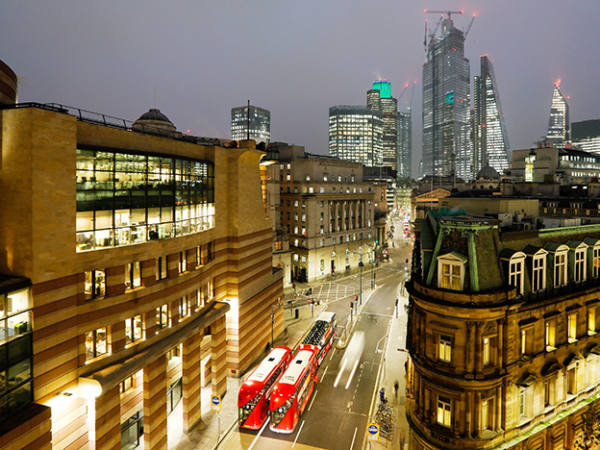In many instances, the Middle East screams luxury: man-made islands crafted to look like palm trees, an abundance of five-star hotels and chauffeur-driven cars are but a few images conjured up by the Gulf States.
That luxury now seems to be seeping into the healthcare market. The construction of the United Arab Emirates (UAE)'s first entirely luxury hospital - The Nucleus Hospital in Mirdif - began late last year. The 150-bed hospital is intended to "pioneer luxury healthcare", according to Dubai-based billionaire Advet Bhambani, the founder of the group behind the venture.
Demand could well be high. Europe's luxury hospitals are regularly frequented by the Middle Eastern elite. In fact, the high-end London Bridge Hospital on the south bank of the river Thames even translates its signs into Arabic.
Luxury healthcare is already common in cities across Europe and North America, particularly when it comes to elective procedures such as maternity services. For example, the Portland Hospital for Women and Children in London offers consultant-led maternity care with additional VIP services such as photography and paintings, 24-hour room service, interpreters and personal shopping. And the maternity ward at Clinique des Grangettes in Geneva has many of the qualities of a five-star holiday, including a Michelin-starred chef offering 24-hour room service.
The Nucleus Hospital is likely to be the first in a new chapter of Middle Eastern healthcare.
The healthcare market - like many of the countries themselves - has grown rapidly. In the UAE, for instance, the infrastructure of healthcare services is increasingly recognised as 'on par' with international standards. The emergence of state-funded healthcare provision helped to eradicate diseases commonly associated with less economically developed countries, such as polio, smallpox and dysentery in the late 1980s. It's a similar story in Saudi Arabia, where an estimated 4.8 per cent of GDP was spent on healthcare provision in 2015, and total healthcare spending is expected to rise to $48bn (£37bn) by 2018. That represents a rise of 6.2 per cent a year between 2014 and 2018.
More recently, the acceleration of the Middle East healthcare market can largely be explained by the emergence of wealth. Higher disposable income not only increases the amount of money people are willing to spend on healthcare, but also raises the likelihood of contracting lifestyle-based illnesses. The health issues that affect many in the region today are those faced by the developed world. Conditions commonly caused by sedentary lifestyles and fast-food consumption, such as obesity and diabetes, are on the rise, as are diseases found among the ageing population, such as heart disease and cancer.
Meanwhile, immigration-driven population growth has put pressure on government-funded healthcare provision. In 2008 this forced the rollout of compulsory health insurance in Abu Dhabi and the same happened in Dubai last year.
But even with the compulsory insurance Middle Eastern governments have generally been keen to promote the use of state-run services over private ones. In fact, last summer Abu Dhabi authorities proposed to cut the amount of cover the compulsory health insurance plan, Thiqa, would provide to those opting to use private hospitals. Under the new regulations, Thiqa patients would have to pay 20 per cent of the cost of treatment at private hospitals, compared with nothing previously.
The outcome of this regulatory change was shown clearly by the results of two London-listed Middle Eastern hospital providers, Mediclinic (MDC) and NMC Health (NMC). In the second half of 2016 both companies reported a drop in patient numbers in Abu Dhabi as more people opted to go with the state-run services rather than private providers which forced out of pocket payment.
Mediclinic - whose share price was knocked badly by the regulatory change - led the revolt against the decision, and in May of this year was rewarded for its efforts when the crown prince of Abu Dhabi reversed the Thiqa co-payment decision. Broker JPMorgan expects this will result in a rapid return of Thiqa patients to Mediclinic and NMC's Abu Dhabi hospitals.
So is this the start of a government more receptive to the benefits of luxury healthcare?
Traditionally, luxury healthcare in the Middle East has fallen under the category of elective procedures, but the concept of a five-star tertiary care facility has been beginning to sprout among private providers.
One of the first healthcare facilities in the UAE to offer dedicated VIP facilities is the Mediclinic City Hospital, which features dedicated lift access to an exclusive area, limousine parking, in-room dining and an entertainment system, as well as a royal suite with a majlis, dining room, patient room and private kitchen. Meanwhile, last year NMC opened its Royal Hospital in Abu Dhabi, a state-of-the-art 250-bed hospital offering a number of specialist treatments.
Slightly further west and the story is different. In eastern Europe healthcare markets are highly fragmented and funded by both governments and patients' own pockets. But with many of these countries also struggling to support ageing populations, demand for better healthcare is on the rise. UK investors have access to this market through Georgia Healthcare (GHG), which was spun out of fellow London-listed group BGEO Group (BGEO) in 2015. What's unusual about GHG is that it is the world's only publicly listed company to hold the leading position in any global healthcare market, with 23 per cent of the total hospital beds in Georgia.
IC VIEW
High culture, GDP and love of luxury hospitality suggests that demand for premium healthcare could well be rising across the Gulf States. In eastern Europe, the specific demands of the market are different, but the need for more and better healthcare is also growing alongside an ageing and expanding population.
This suggests that the market is ripe for investment. However, there are still concerns with individual geographies that must be taken into account.
Growth in the Middle East correlates with the oil price, which has struggled of late. And whether there's demand or not, a weak economy may limit the growth in healthcare, particularly if fewer patients opt to go private. The two London-listed players are also not the only companies to find the market attractive, leading to intense competition in the region. And, although the take-up of insurance in Dubai has, so far, been good news for private providers, the launch of a co-payment system could dampen demand in the near term.
Georgia meanwhile remains a high-risk country to invest in. Although GHG's chief executive, Nick Gamkrelidze, is confident in his assurances that the country is "criminal and corruption free", there's also no denying that Georgia is in a "tough neighbourhood".
Favourites
NMC's diversity across the Middle East gives it a much stronger footing than its closest rival, Mediclinic. The group has enjoyed an impressive share price trajectory in recent years as it's grown its hospital footprint to 679 beds. It also hosts a complementary medicine distribution division, where double-digit revenue growth has been steady, without the help of bolt-on acquisitions.
We also like Georgia Healthcare's dominant position in a growing and fragmented market, but still consider the geographical location a little risky to turn bullish on the shares.
Outsiders
As well as its Abu Dhabi hospitals, Mediclinic has a presence in Switzerland and its native South Africa. These two divisions have been performing well, and in a recent trading update it was only the Middle East division where revenues were down. While we do think that there could be substantial improvement in this division now that the Thiqa co-payment decision has been overturned, there remains a lot of competition in the region, which could stunt growth opportunities.










